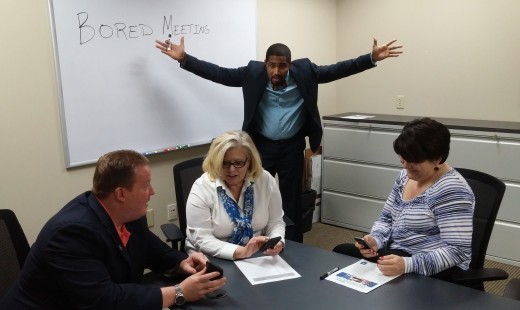How to Fix Your Boring Meetings
Have you ever fallen asleep during a meeting with your eyes wide open? Okay, maybe you weren’t completely in snooze mode, but your mind was elsewhere and you couldn’t remember the last comment that was made. Surely I’m not the only one…
There’s only one thing worse than getting caught daydreaming in a meeting, and that’s being the person leading it from the other side of the conference table. You’re trying to share project updates and they’re either watching the clock or checking their phones.
Clearly, there’s a disconnection. So, how can we make meetings better?
As ethical leaders, it’s your responsibility to help employees see how their specific roles support the mission of your organization. By articulating how even the most tedious or seemingly insignificant tasks are meaningful, worthwhile, and connected to your company’s mission, you can better engage your team in meetings.

But let’s face it, we all run out of steam at times. Sometimes it takes new strategies to help each other refocus and reengage at work, especially in meetings. Here are five such strategies:
1. Revise Your Agenda
I believe agendas can be useful, but many are not. If you’re still handing out a sheet of paper that says “Agenda” at the top and has a few one-word bullet points, I have a better solution for you.
Consider adding clear meeting objectives to the top of your agenda. If conversations arise that don’t relate to the objectives, let the group know that you need to focus on topics related to the meeting objective first, then you can circle back to other topics later, if time permits. I also recommend putting time estimates and discussion leaders next to each agenda item, to help meeting participants see how much time is needed to discuss the remaining topics.
2. Allow People to Make a Case for Why They Shouldn’t Attend
We’ve all sat in certain meetings, wondering why we were invited. Send a detailed agenda at least one day before the meeting, and invite people to contact you if they don’t believe the meeting objective or content is relevant to them. If they make a good case, let them pass on attending. Otherwise, it provides you with an important opportunity to explain why their participation in the meeting is so important.
3. Let Other People Share Their Own Ideas
While leading a meeting, I once presented all of my ideas, then summarized some of the ideas that others previously mentioned to me. They were all in the meeting, and I made sure to give them credit for their ideas. I thought I did a great job of lifting them up and talking about how great their ideas were. Not so much.
My boss pulled me aside later and pointed out that I might have better involved the rest of the meeting participants if I had just asked them to share their own ideas, rather than summarizing it for them. It was a great lesson, and I now use that experience to help keep others engaged, during meetings.]
4. Challenge the Standard Meeting Duration
Do we really have an hour worth of things to discuss, or was it just the default setting when we scheduled the meeting in Outlook?
Some meetings actually will necessitate an hour or more, but most do not. Consider scheduling a 15 or 30 minute meeting, based on the amount of content that needs to be discussed. This can reduce off-topic conversations, too, because everyone realizes they have limited time to accomplish the meeting objectives.
5. Be Honest and Give Feedback
Have you ever been in a meeting where the leader asked to everyone to share their ideas on a matter, only to then decide to not use any of them? It can make the meeting seem like a big waste of time.
As leaders, it’s important to be genuine when you ask for your team’s ideas. You don’t always have to go along with someone else’s suggestion, but you do owe it to them to explain why you’re going in a different direction. Otherwise, they’ll soon believe that the only opinion that matters is your own.
You can’t always control whether or not someone pays attention in your meetings. But you can make efforts to show more consideration for their time and contributions to the meeting. Use the way you run meetings as an opportunity to show your team that they’re valued, and you’ll soon find their time and contributions to be invaluable.
Always remember, Leadership is a Lifestyle.
— Ryan W. Hirsch
Program Manager, NASBA Center for the Public Trust
